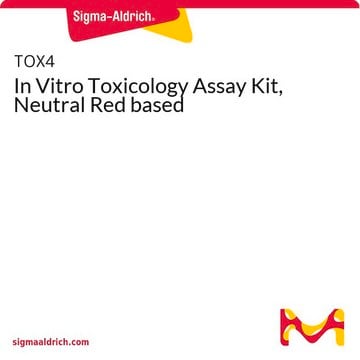For staining dinoflagellates using Neutral Red powder, it is recommended to use the same basic formulation as the Neutral Red solution offered as catalog number N2889, which is stated to be 3.3 g/L dissolved in a DPBS. It should be possible to dissolve in any suitable cell culture media that does not contain phenol red in the formulation. Neutral Red is a vital stain, so the dye needs to be dissolved into an isotonic solution and should not be dissolved in water.
861251
Neutral Red
certified by the BSC
Synonym(s):
3-Amino-7-dimethylamino-2-methylphenazine hydrochloride, Basic Red 5, Toluylene red
Select a Size
About This Item
Recommended Products
agency
certified by the BSC
Quality Level
form
powder
composition
Dye content, 50-60%
technique(s)
titration: suitable
pH
6.8-8.0, red to yellow
mp
290 °C (dec.) (lit.)
solubility
water: 1 mg/mL
λmax
540 nm
application(s)
diagnostic assay manufacturing
hematology
histology
storage temp.
room temp
SMILES string
Cl.CN(C)c1ccc2nc3cc(C)c(N)cc3nc2c1
InChI
1S/C15H16N4.ClH/c1-9-6-13-15(8-11(9)16)18-14-7-10(19(2)3)4-5-12(14)17-13;/h4-8H,16H2,1-3H3;1H
InChI key
PGSADBUBUOPOJS-UHFFFAOYSA-N
Looking for similar products? Visit Product Comparison Guide
Application
Biochem/physiol Actions
Suitability
Storage Class
11 - Combustible Solids
wgk_germany
WGK 3
flash_point_f
Not applicable
flash_point_c
Not applicable
ppe
Eyeshields, Gloves, type N95 (US)
Choose from one of the most recent versions:
Already Own This Product?
Find documentation for the products that you have recently purchased in the Document Library.
Customers Also Viewed
-
How to prepare Neutral Red 861251 for staining dinoflagellates?
1 answer-
Helpful?
-
-
What percentage is this neutral red solution?
1 answer-
The dye content specification for this product is 50 - 60% Neutral Red. The exact percentage is lot-specific and will be reported on the Certificate of Analysis. See the link below for a sample Certificate of Analysis:
https://www.sigmaaldrich.com/coa/SIAL/861251/11714LEHelpful?
-
Active Filters
Our team of scientists has experience in all areas of research including Life Science, Material Science, Chemical Synthesis, Chromatography, Analytical and many others.
Contact Technical Service








